What are the animals in Kruger Park in South Africa? The answer is that there are lots of animals, including mammals, reptiles and birds. The most famous are of course the 'big five' - elephant, lion, buffalo, leopard and rhino.
Innehållsförteckning
Kruger Park in South Africa
The Kruger Park, or Kruger National Park, is located in the north-eastern corner of South Africa, not far from the border of Mozambique. The park, named after former President Paul Kruger, is oblong and the size of Slovenia.
Animals in the Kruger Park in South Africa
There are lots of different animals in the Kruger Park. Although the 'big five' are the most famous, you can also spot many other interesting species. You get around the park by car - either your own/rented car or as a guest in a safari car - and watch the animals from the vehicle.
Because of the abundance of wildlife, and because many animals have little interest in cars, it's easy to see wildlife up close. At night, you can stay in the area, in fenced 'camps' - in your own campervan, in a glamping tent or in a hotel.
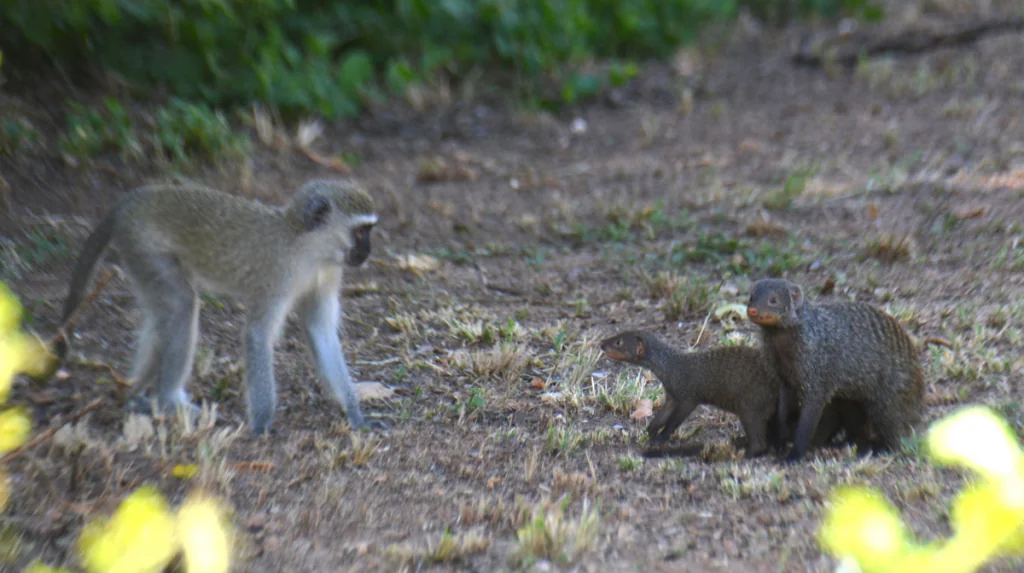
Tips for seeing - and identifying - animals in Kruger Park
Many animals are easy to see just by driving through the park, while others may require some luck and effort. Here are some tips for spotting the animals:
- Early mornings and evenings are the best time to see animals.
- Drive slowly, scout and stop at ponds, viewpoints, small exits, etc.
- Check where other cars (especially safari cars) stop and see where they point their binoculars/camera. You can also ask - many are helpful!
Bring binoculars and/or a camera with a lens and possibly an animal book. The larger campsites have shops, and in one of these we bought a booklet with maps, information and pictures of all the animals, along with small "checkboxes". Fun! We ended up ticking 29 mammals and reptiles and 30 birds. We probably saw even more birds, but it was difficult to identify them all.
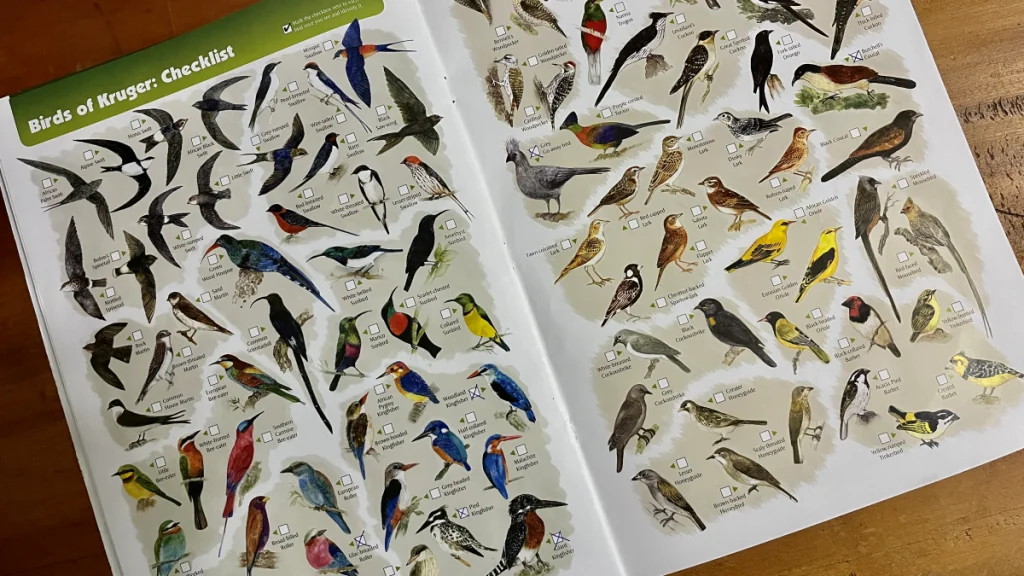
The Big Five
When talking about animals in the Kruger Park, many people think of 'The Big Five'. These are elephant, lion, buffalo, leopard and rhino.
elephant you see all the time in the Kruger Park. There are many of them, and they are everywhere. Even though they are easy to see, it is an experience because they are so powerful. Sometimes you can see large herds, or cute little baby elephants.
Usually they are calm, but they can get annoyed, and then you have to back off. An elephant stood on the road as we drove along and as we approached he started waving his ears in warning and walking aggressively towards us. Then we just had to back up, quite a bit ...
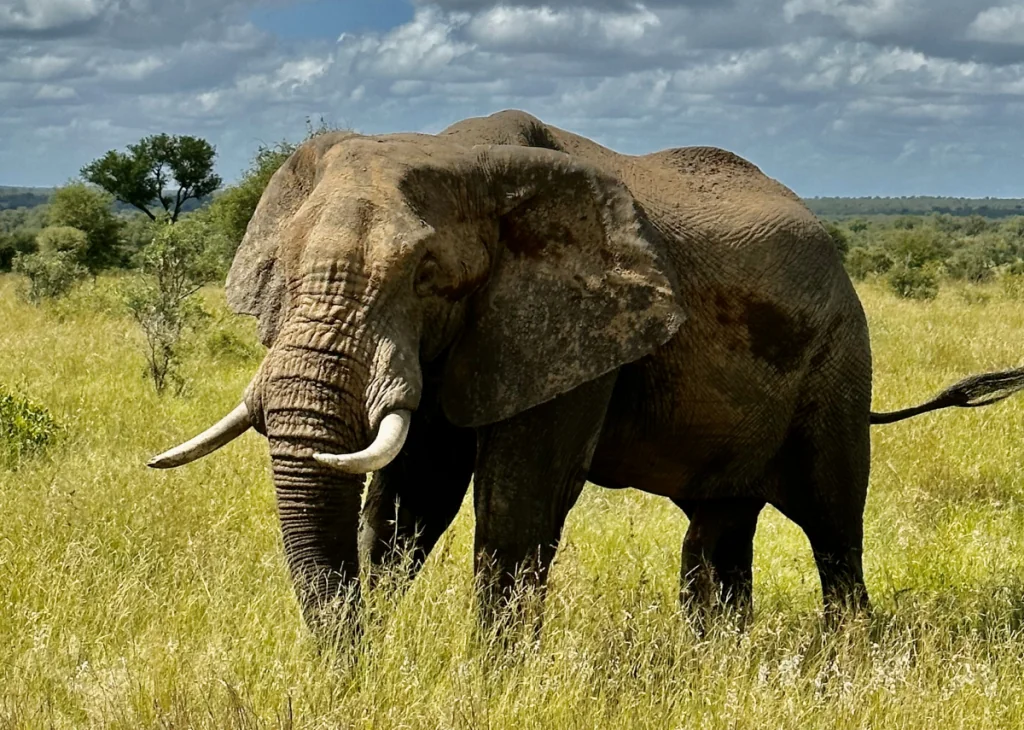
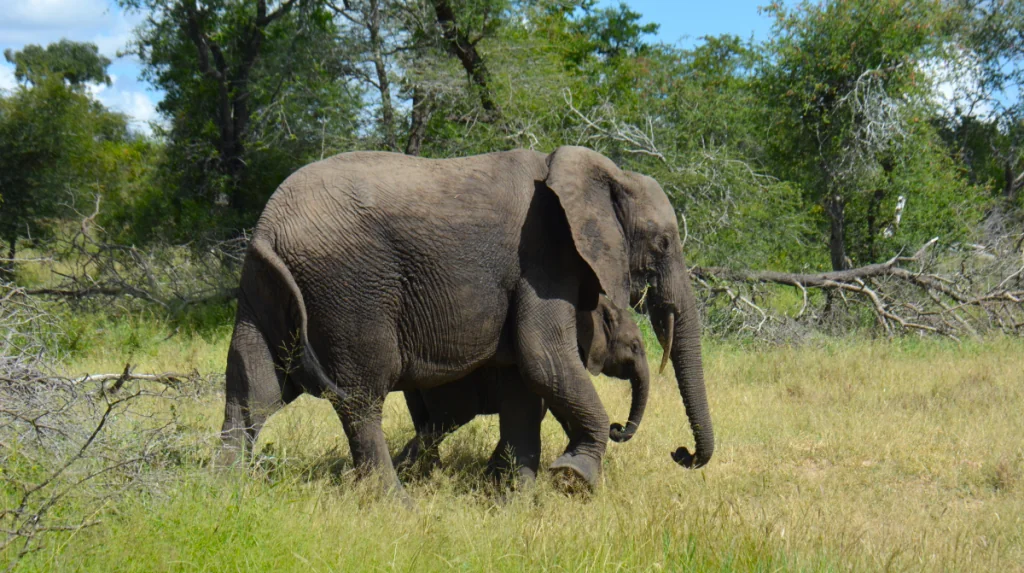
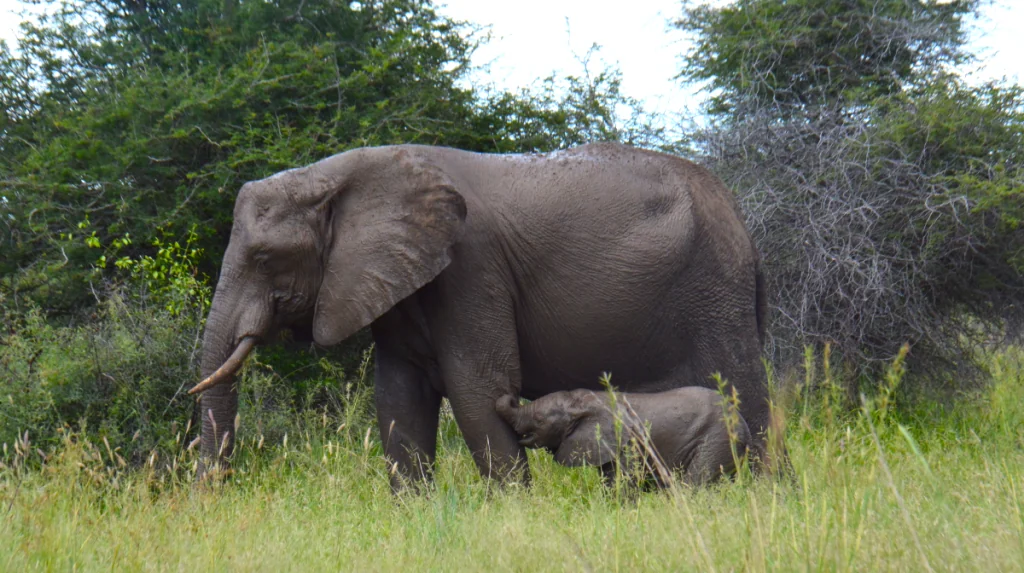
Lion was also not difficult to spot, at least not when we were here. The lions are completely unafraid of (or rather completely uninterested in) cars and therefore it is sometimes possible to get very close to them. We saw several times female lions on the road. Sometimes they were looking for prey. Other times they lay down to rest next to a car. One female lion came straight towards us to ... pee!
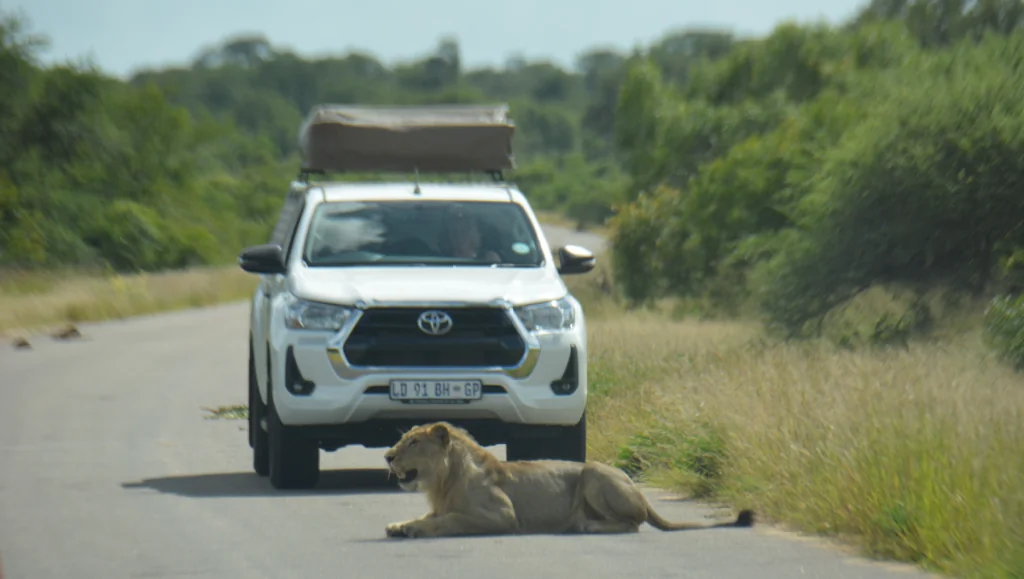
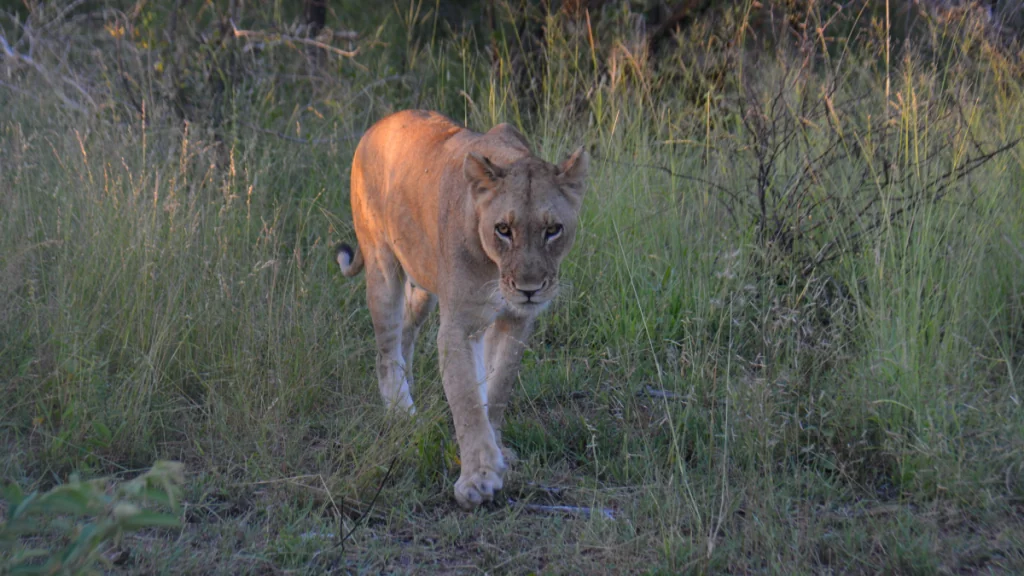
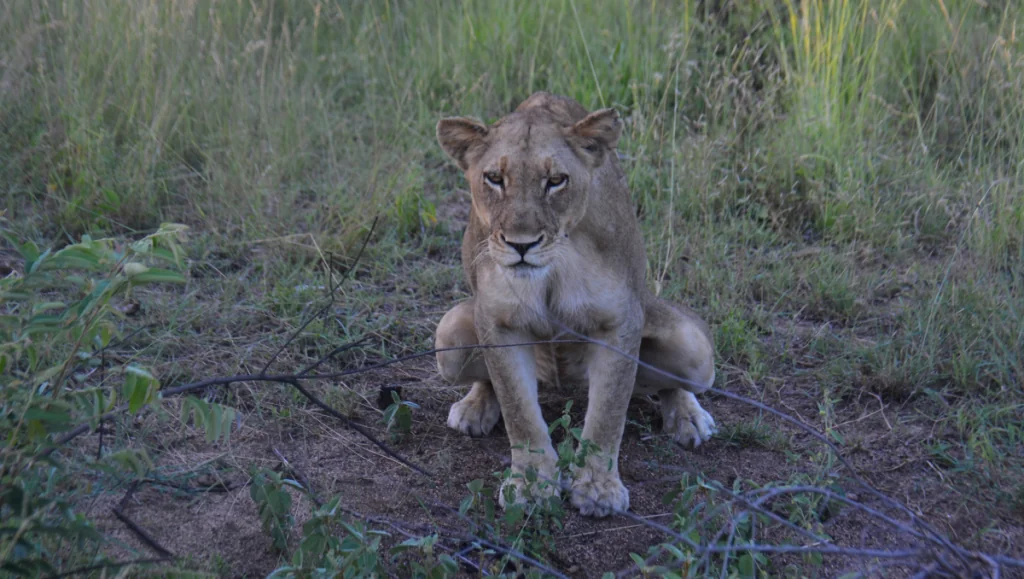
Buffalo we saw only after a few days, and then we saw many at once. Buffalo apparently like to hang out in the bath, and here they seemed to have a cosy moment while small birds pecked them on the back. The fact that we were standing right next to them, in our car, did not bother them much ...
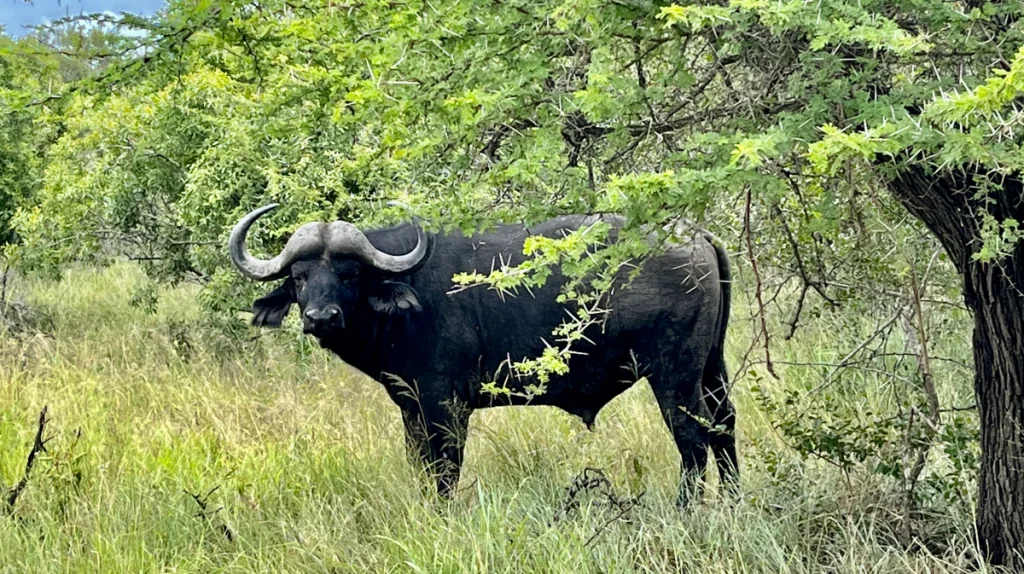
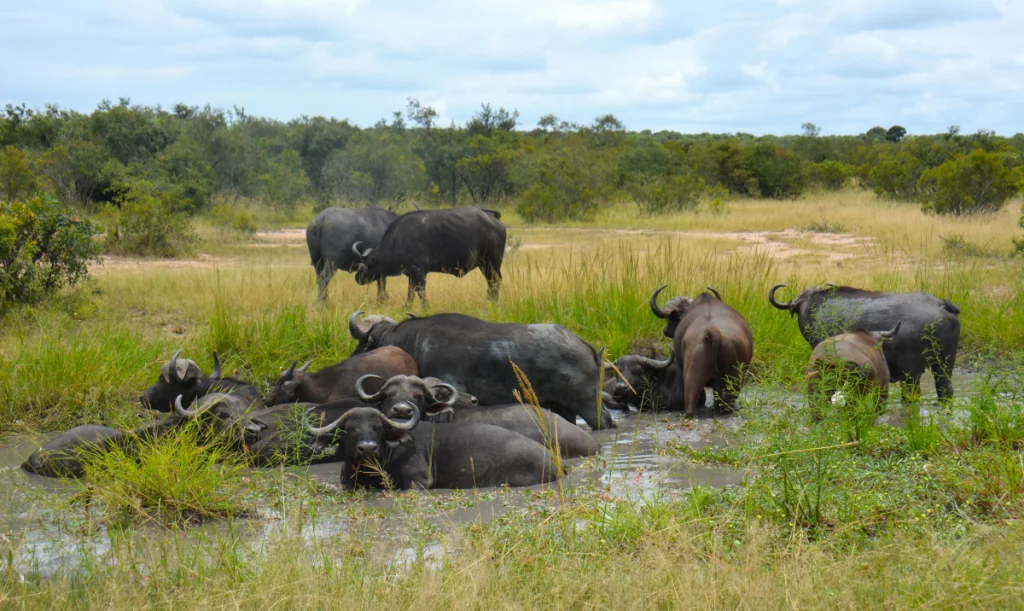
Leopard can be difficult to spot, but we got lucky and saw the animal several times. First we saw a leopard up in a tree, where it had a prey in the form of a dead impala. However, the best photo we got was when we were out on an organised evening tour in the dark. Then a leopard chose to walk next to the safari car.
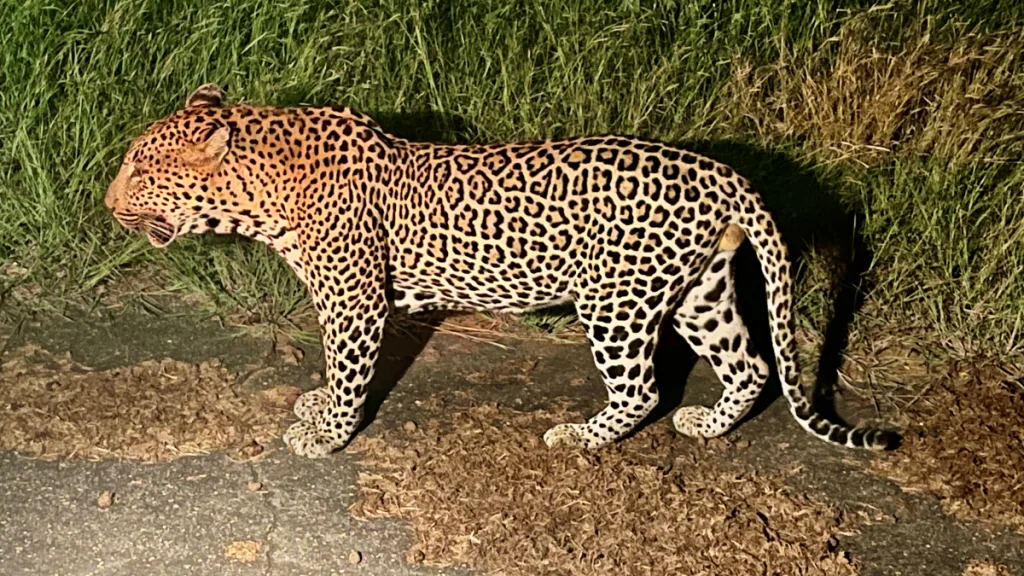
Rhinoceros were, for our part, the most difficult to spot. We only saw rhinos on one occasion, and that was at a relatively long distance. We saw them anyway, which meant we could tick off "the big five!"
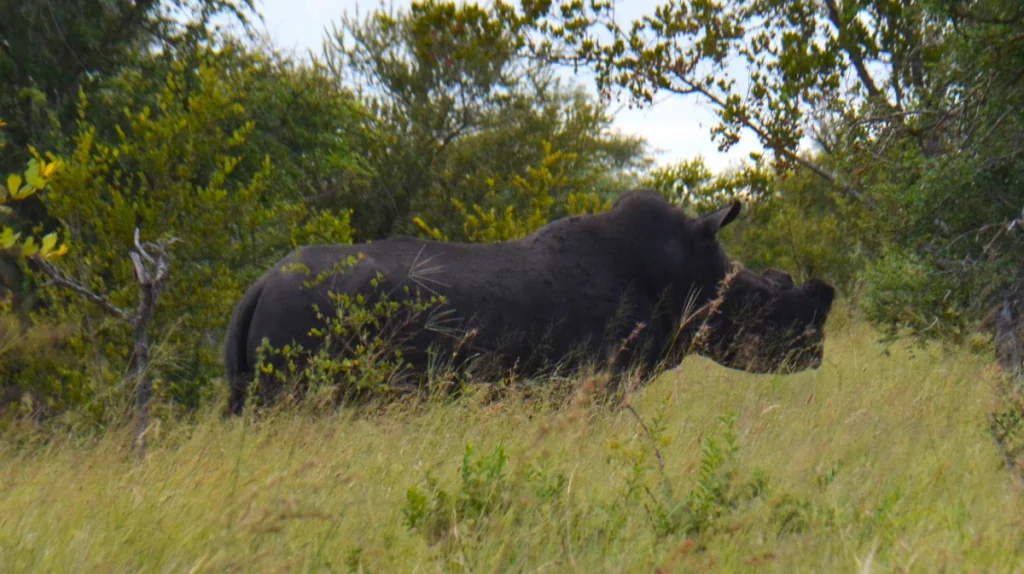
Animals in Kruger Park - mammals
There are lots of different types of mammals in Kruger Park, in addition to the big five. Some are easy to spot, and others are a little more challenging.
Impala is perhaps the animal you see all most. These animals are everywhere and move in large packs. We have heard many people call them "McDonald's" as they are probably a common meal for the various predators.
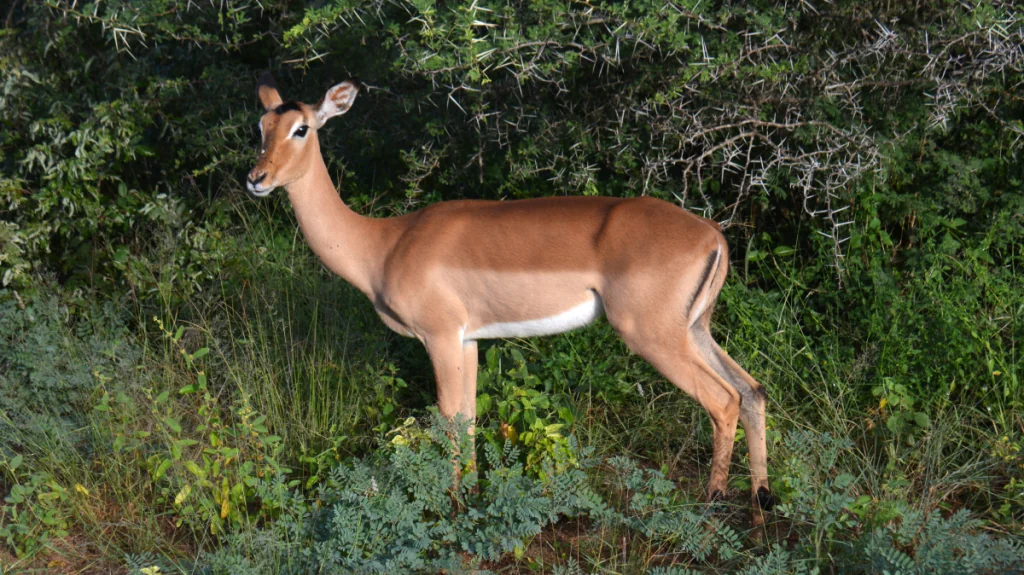
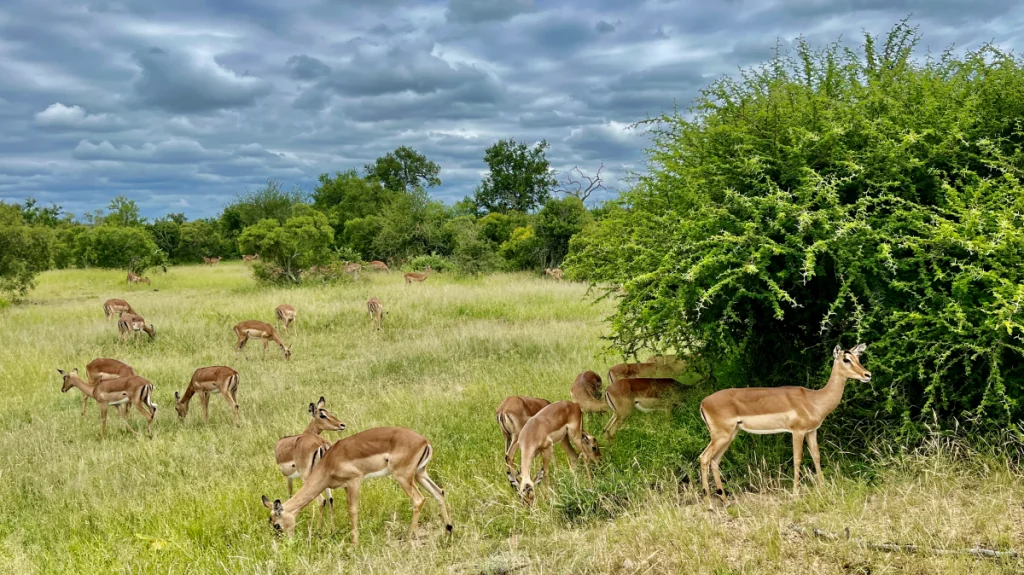
Giraffe is very easy to spot, but even if it is easy, it is a fascinating experience. Giraffes are big and beautiful, and sometimes you are lucky enough to see a baby too.
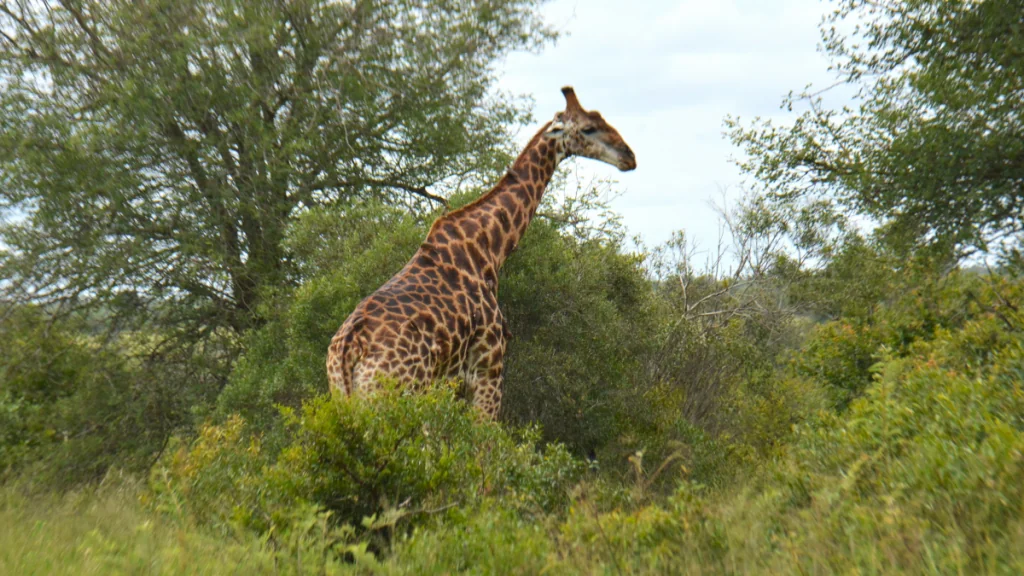
Zebra is also easy to spot. Zebras are incredibly beautiful with their stripes, and like to hang out with wildebeest, impala and other grass-eating animals.
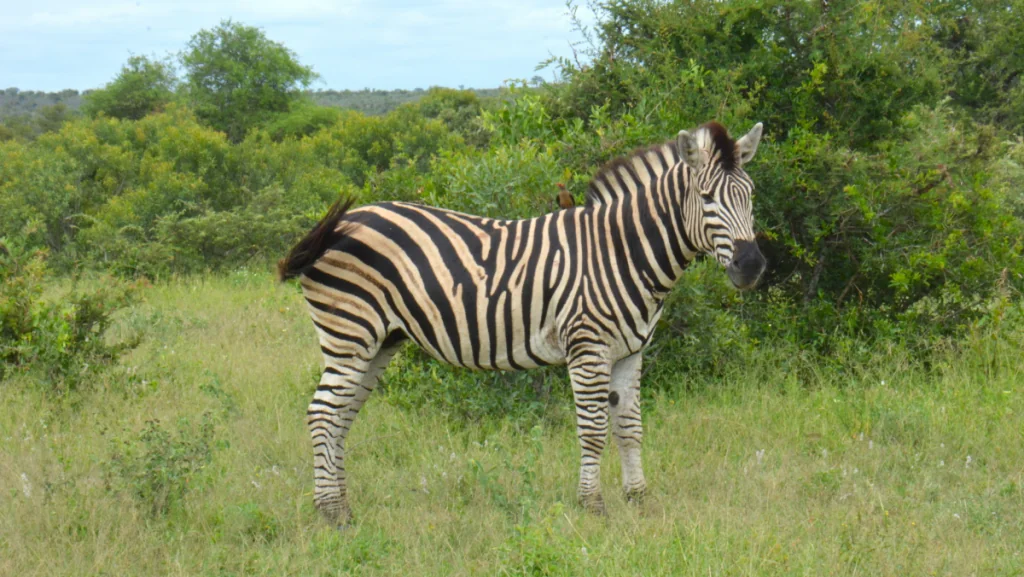
Gnu, or Blue Wildebeest as it may also be called in English, is another hard-to-miss animal in the Kruger Park.
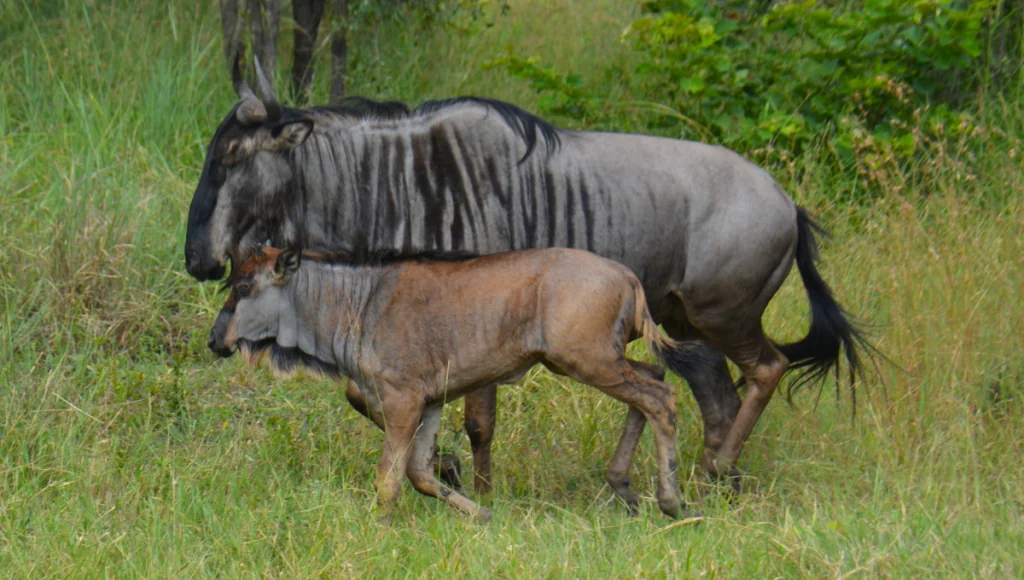
Larger kudu is also a beautiful animal to watch. The males have large, powerful, curved horns.
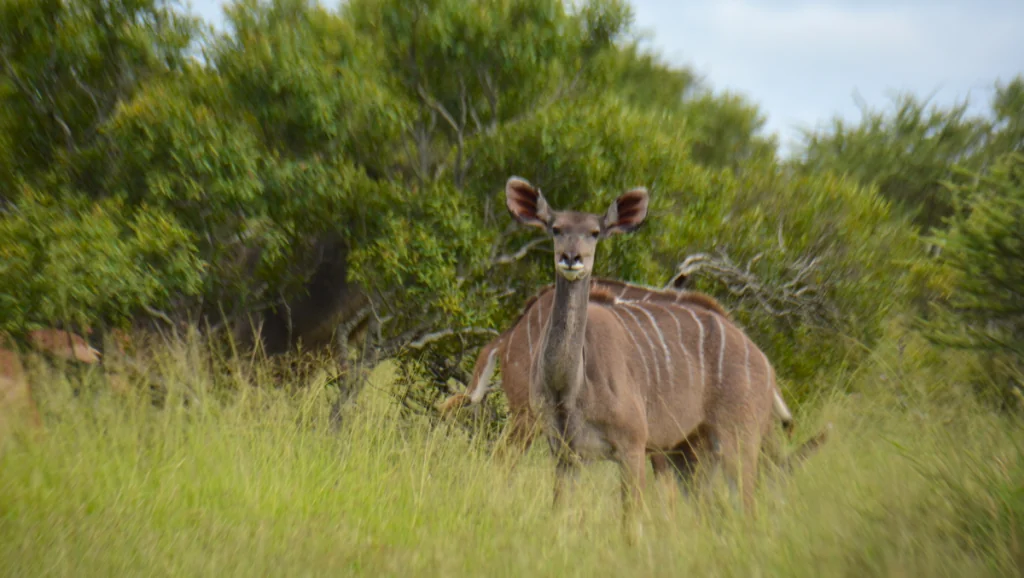
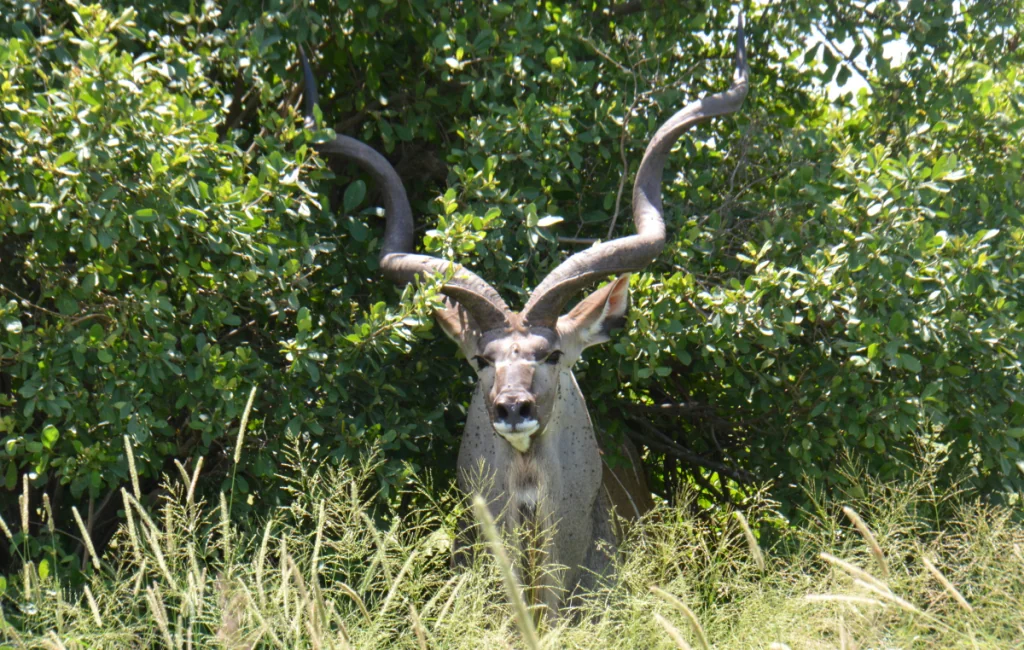
Elliptical water buoy we saw more rarely, but still on several occasions. The arse looks like it has been sitting on a white painted toilet seat ...
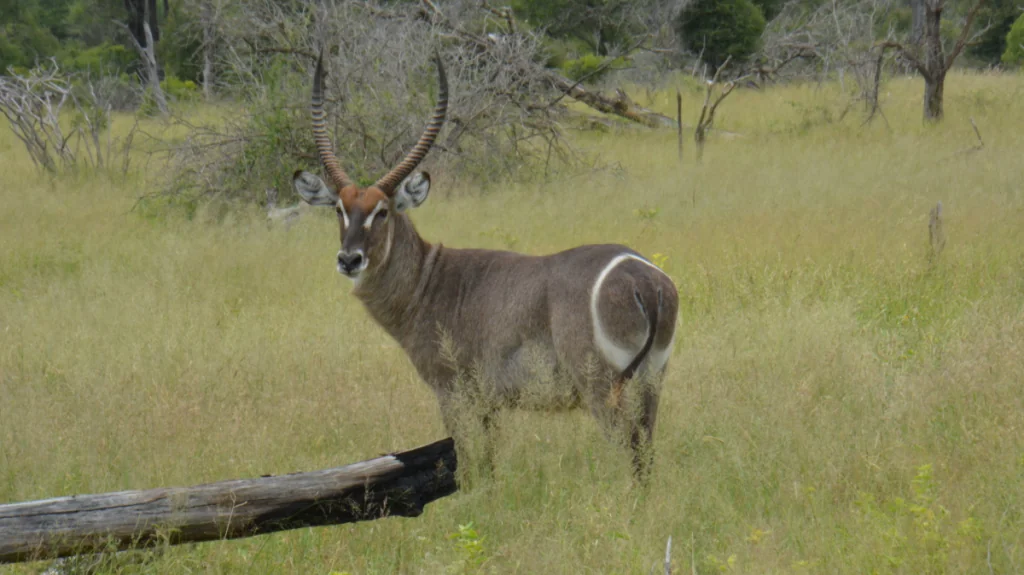
Rock jumpers is not easy to spot, but a tip is to look up on the cliffs when driving past them. There it can stand and look out over the landscape.
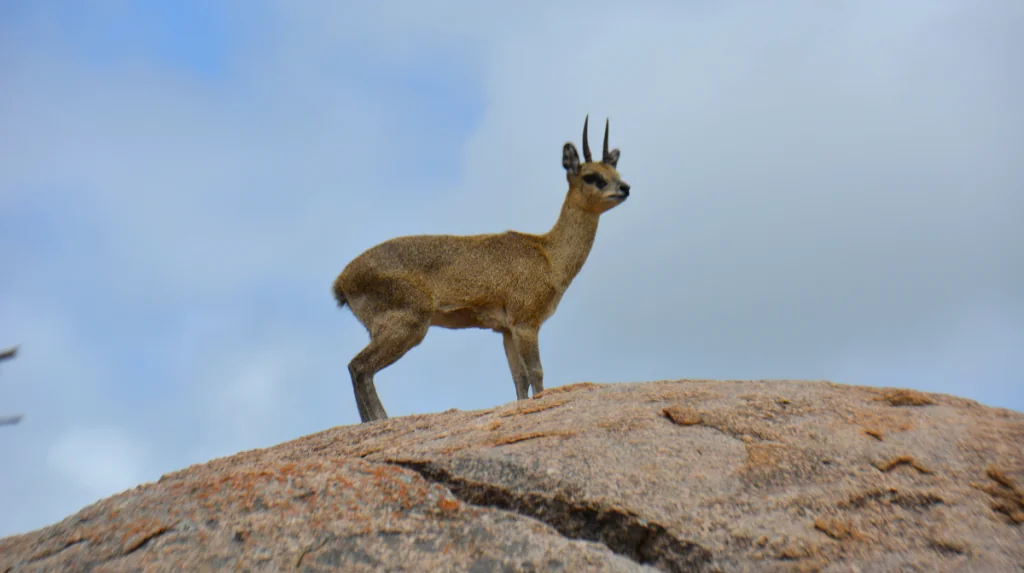
Hippopotamus is a large and powerful animal, but often you can only see a small piece of them sticking out of the water where they are sheltered from the heat.
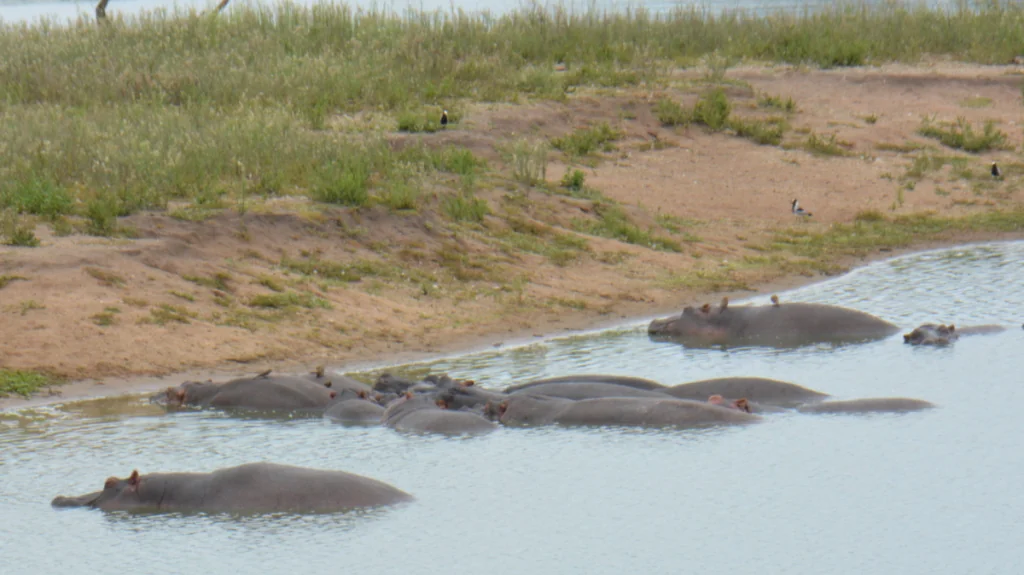
Warthog we saw only a few times, often together with other animals.
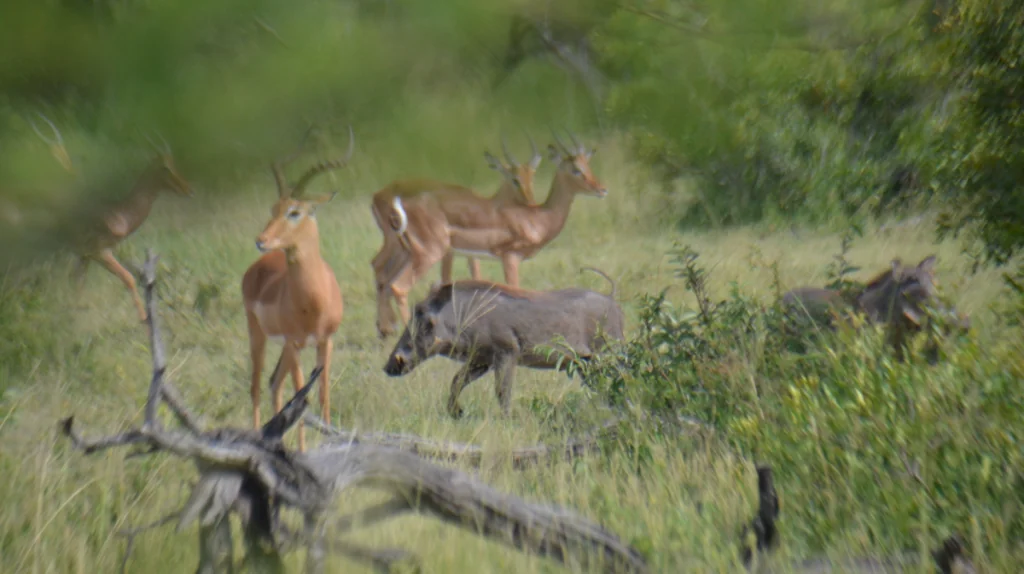
Babian is an animal in the Kruger Park that is abundant. We saw them here and there, sometimes in the trees and sometimes on the road. Once a large group of baboons swung into the campsite where we stayed. The campsites are surrounded by high fences, but there is nothing to stop a baboon swinging from branch to branch ...
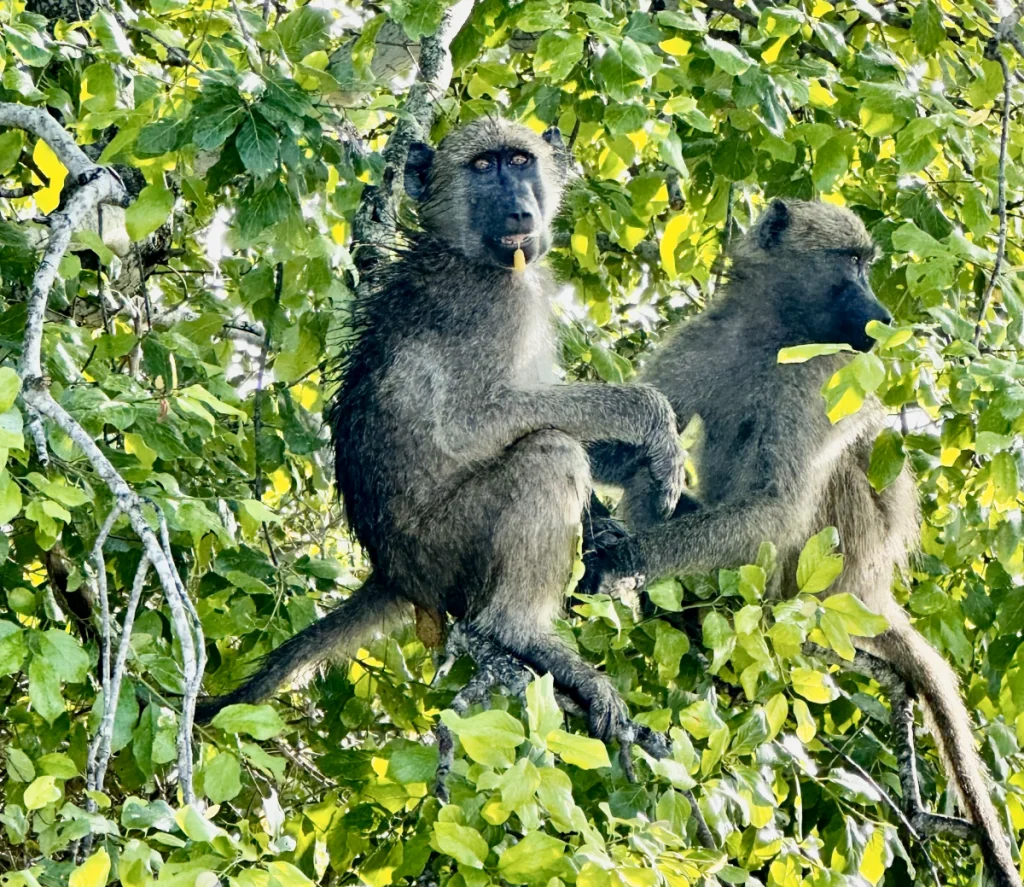
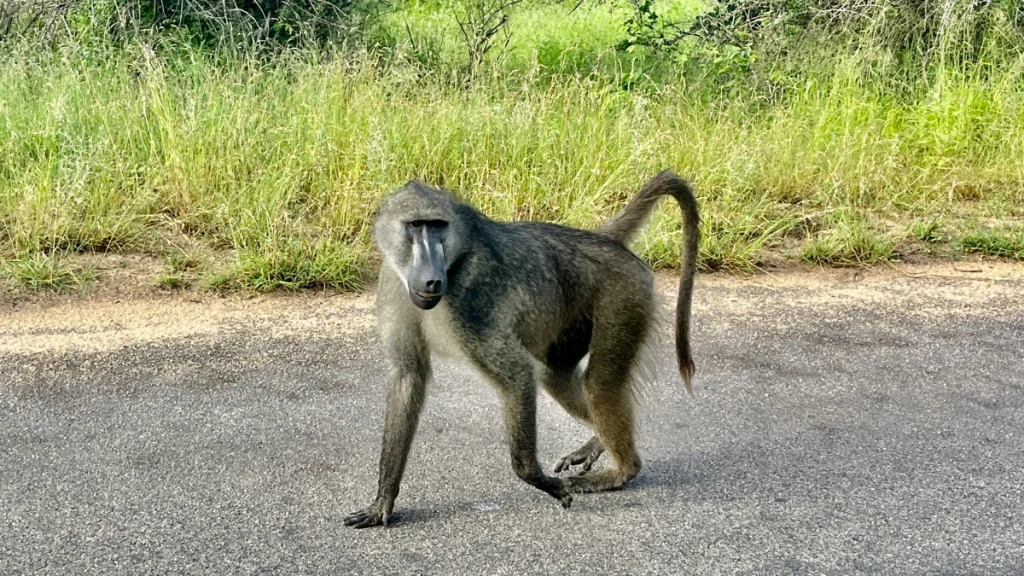
Markatta is a smaller kind of monkey that you also see often, mostly inside the campsites where they like to try to grab fruit and other edibles from the unsuspecting campers. We didn't have time to take many good photos, as we were busy keeping them away from our storerooms ...
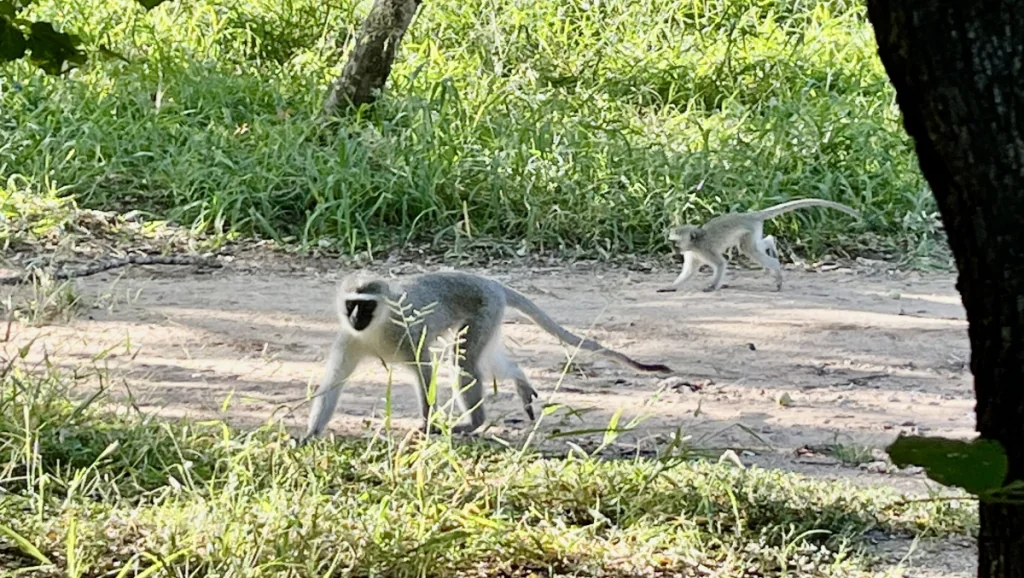
mongoose or mongoose is another animal that we saw both inside the campsite and on the road. Fast, playful and fun to watch! I (Helena) was delighted because I suddenly remembered the children's book Rikki-Tikki-Tavi, by Rudyard Kipling, about an Indian mongoose.
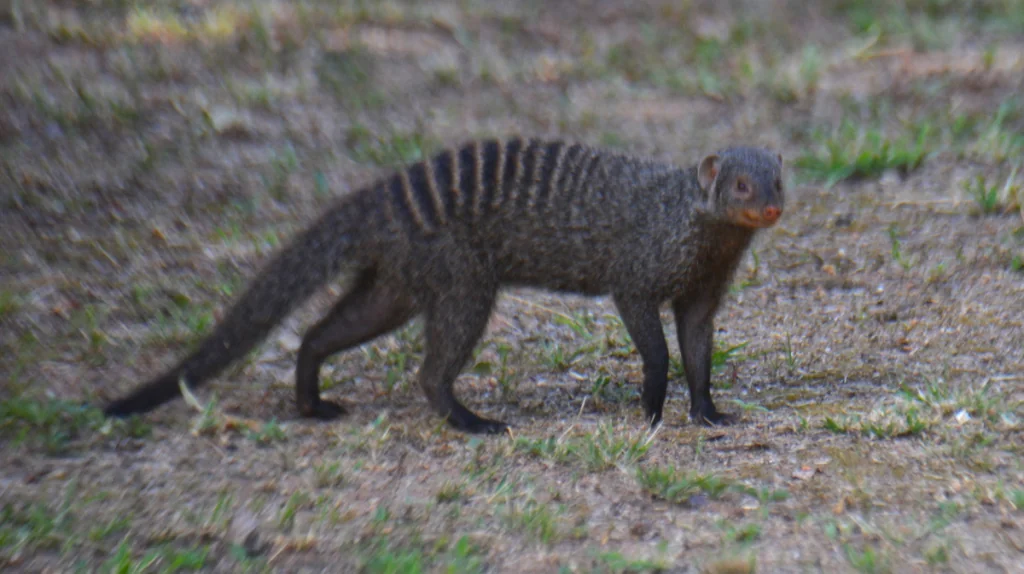
Squirrel is perhaps not so exotic, but oh so cute! They were surprisingly fearless and one ran around very close to us, at our campsite.
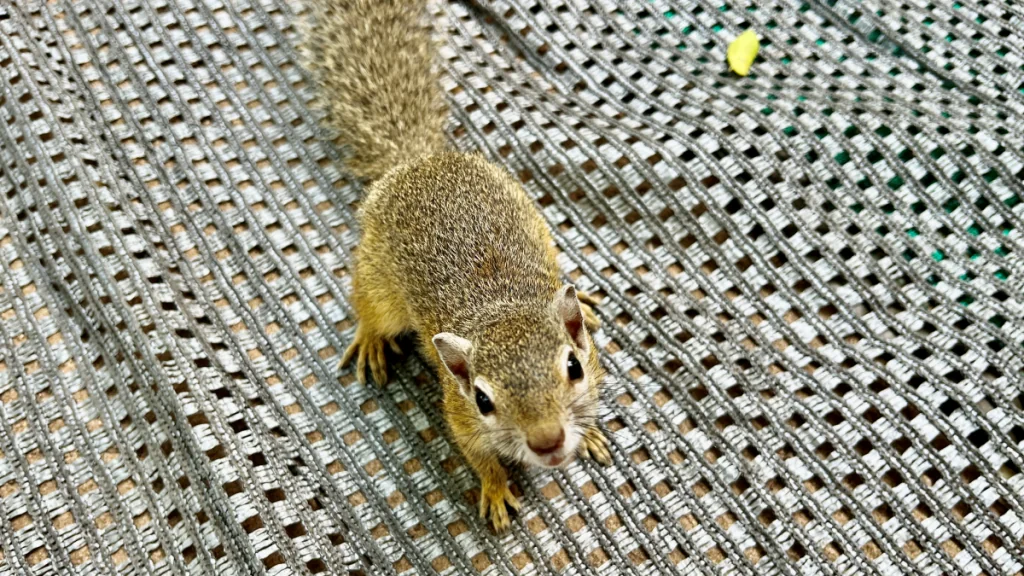
Hyena is a fascinating animal, and we saw them on several different occasions. One mum had hidden her babies at the edge of the ditch and another family, with slightly bigger kids, were resting on the road. A hyena, who we came to call "Fluffy" was begging for grilled meat outside the campsite fence, which is a sad result of some campers feeding the wild animals. This, of course, is not good and in the worst case scenario can lead to the animals having to be euthanised.
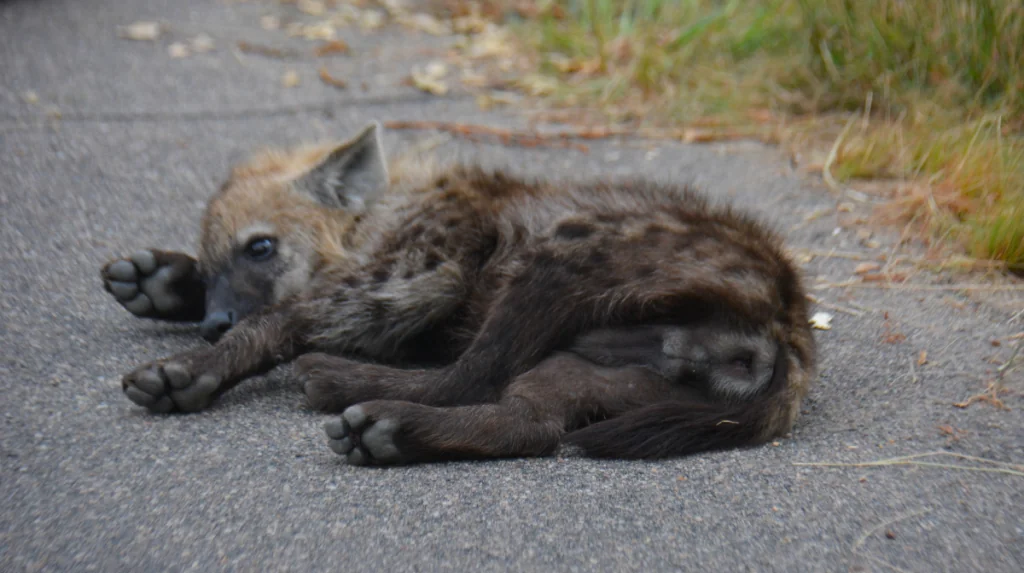
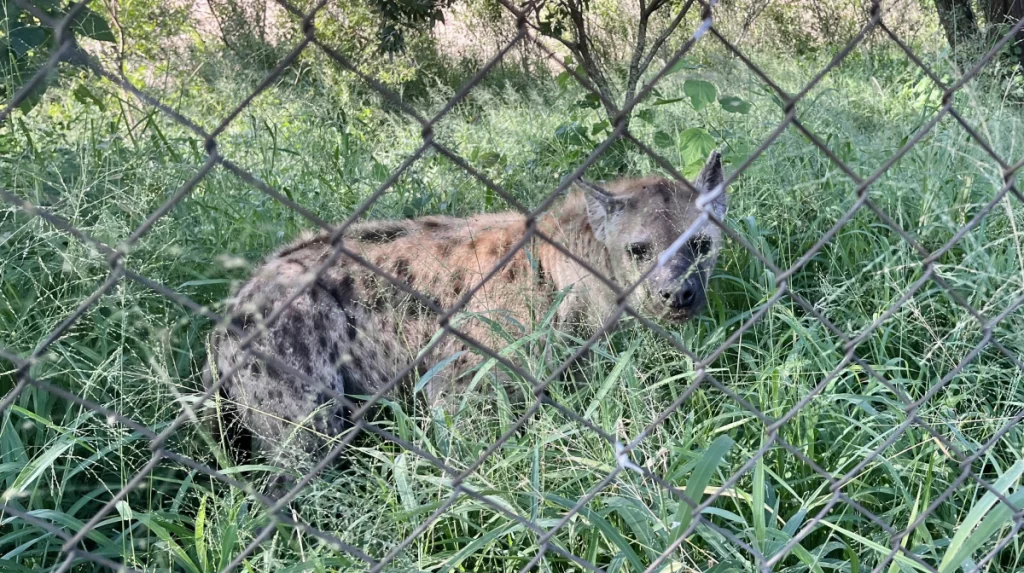
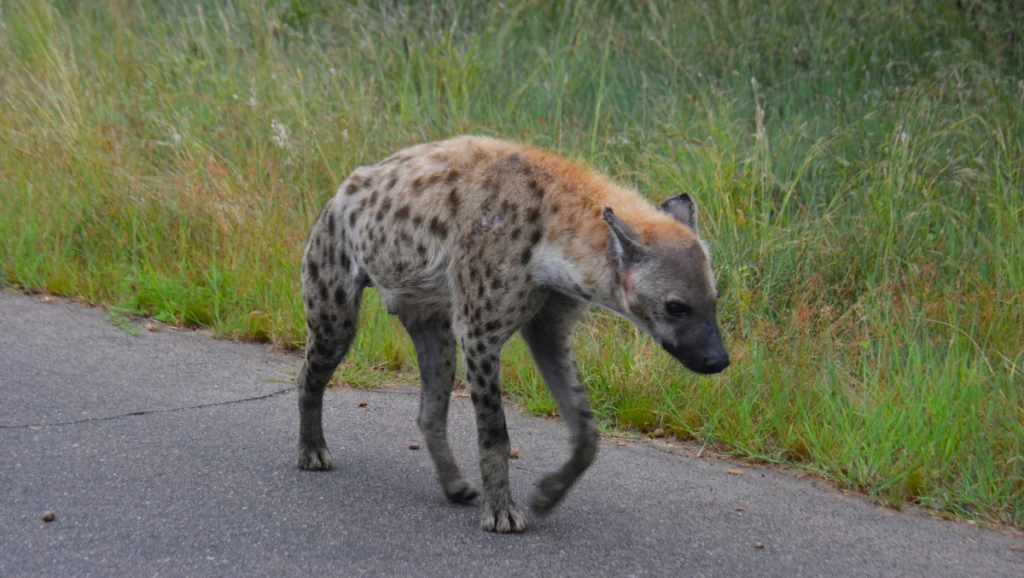
Wild dog coves really difficult to spot, so we were very lucky. A whole bunch of wild dogs were hanging around a stream, and we could watch them from a distance. These rascals hunt large prey in groups and then eat the prey directly, while it is still alive.
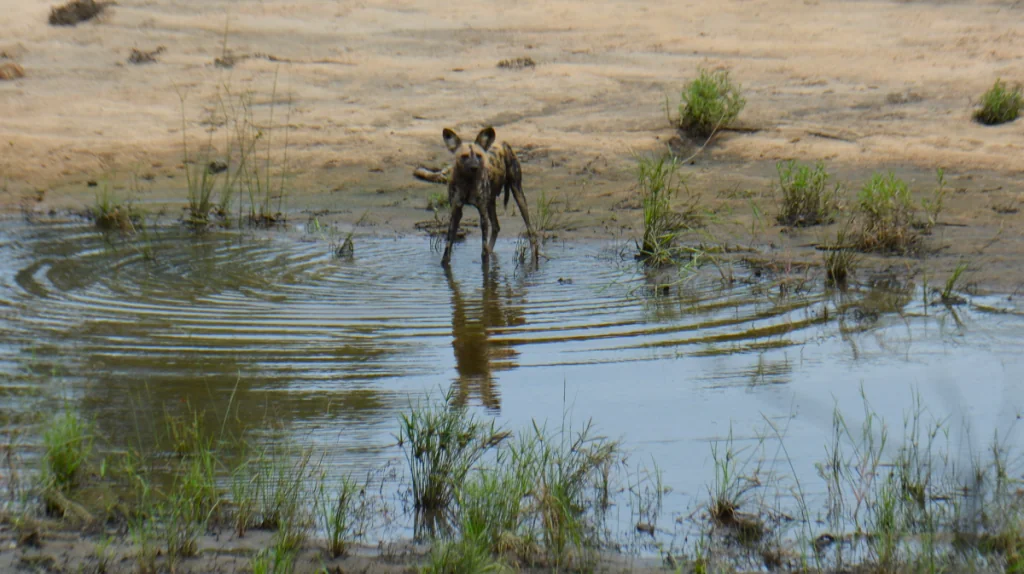
Jackal is not very easy to spot either. Thanks to our South African friends, we managed to spot one from a distance.
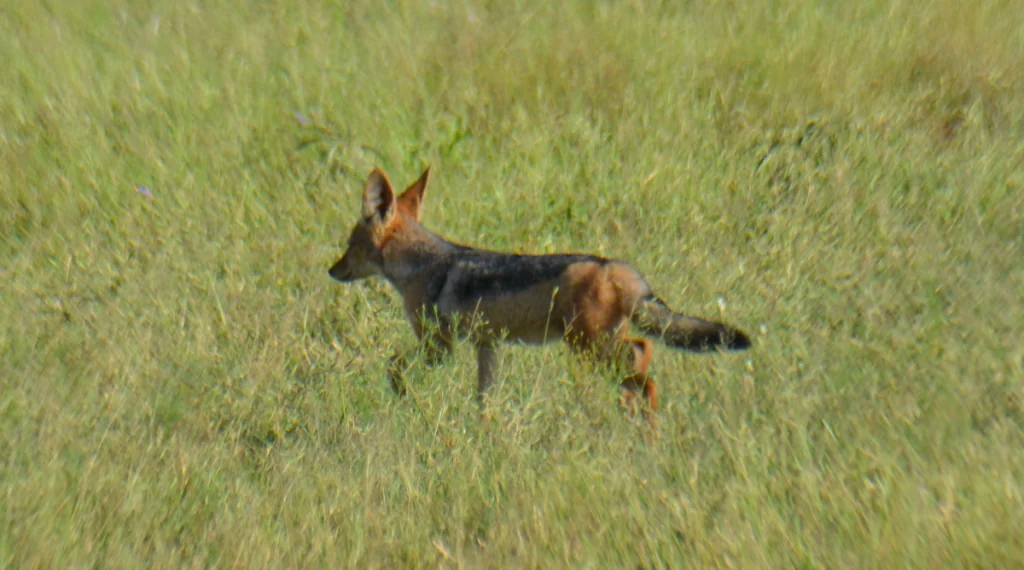
Other mammals we saw were stone antelope and hare. Mammals like us not saw, but which are possible to see, include, among others common moose, nyala, cheetah, desert island and rock hyrax.
Reptiles
There are not only mammals to spot in the Kruger Park, but also reptiles of various kinds.
Crocodile shouldn't be too hard to spot, they say, but we only saw two, on one occasion. We saw these when we were out on an organised evening tour, with a larger safari bus.
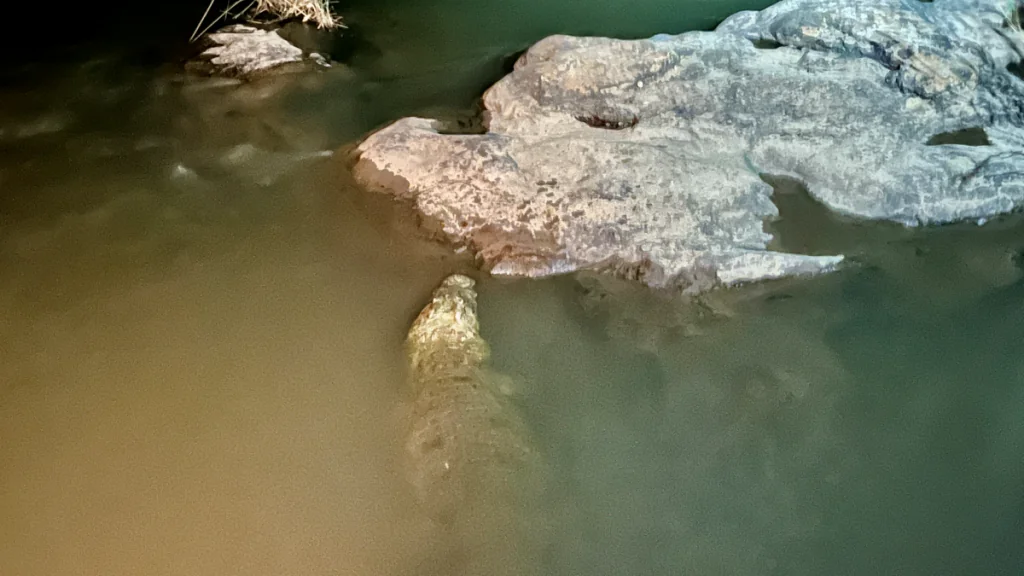
Iguana we saw twice. The first one we saw was climbing a tree. The second ran past our camping neighbours at the campsite.
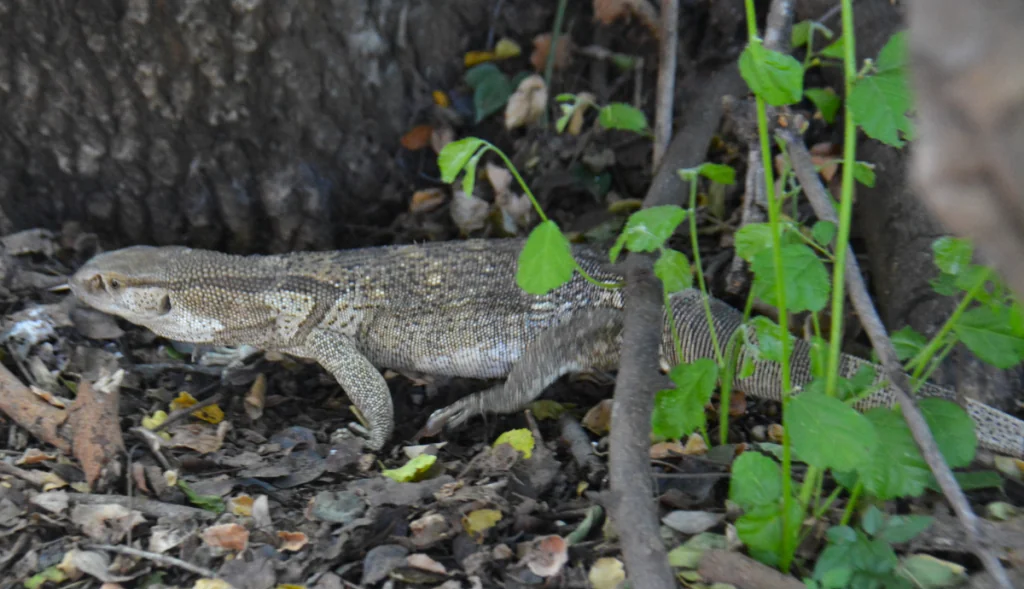
Chameleon we saw it on the road ahead, or rather, our South African friends saw it. How they managed it, we don't know, because it was well camouflaged and blended almost imperceptibly into the tarmac.
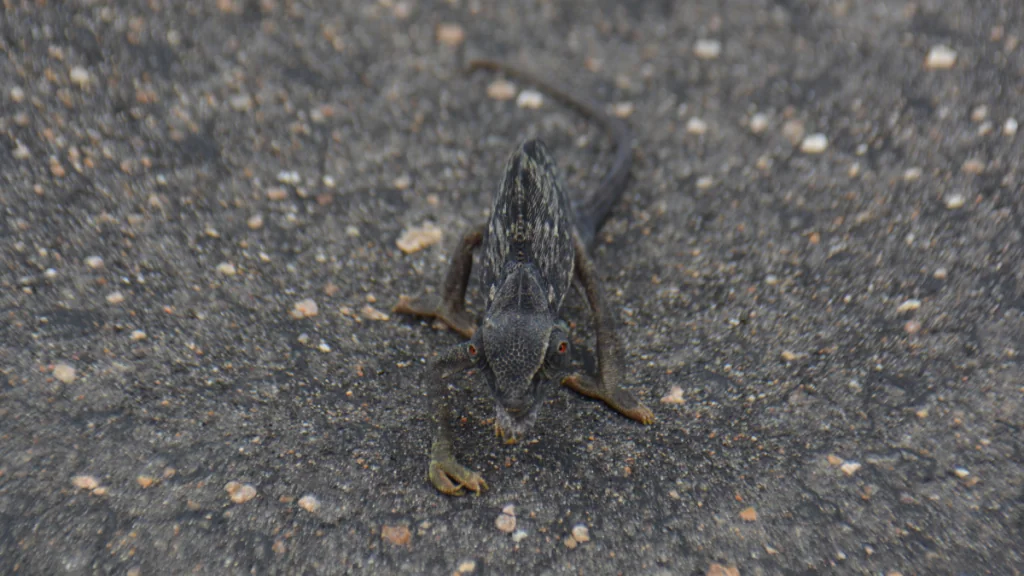
Other reptiles we saw were turtle and the snake boomslang (unfortunately seriously damaged by a car). In addition to these, there are several other types of snakes.
Birds
If you like bird watching, you can really get your fill in the Kruger Park. We saw lots of birds, ranging from vultures and mighty birds of prey to colourful little birdies. Here is a small selection.
Giant Kingfisher we saw several times, a very beautiful bird that also liked to sit still so we could photograph it.
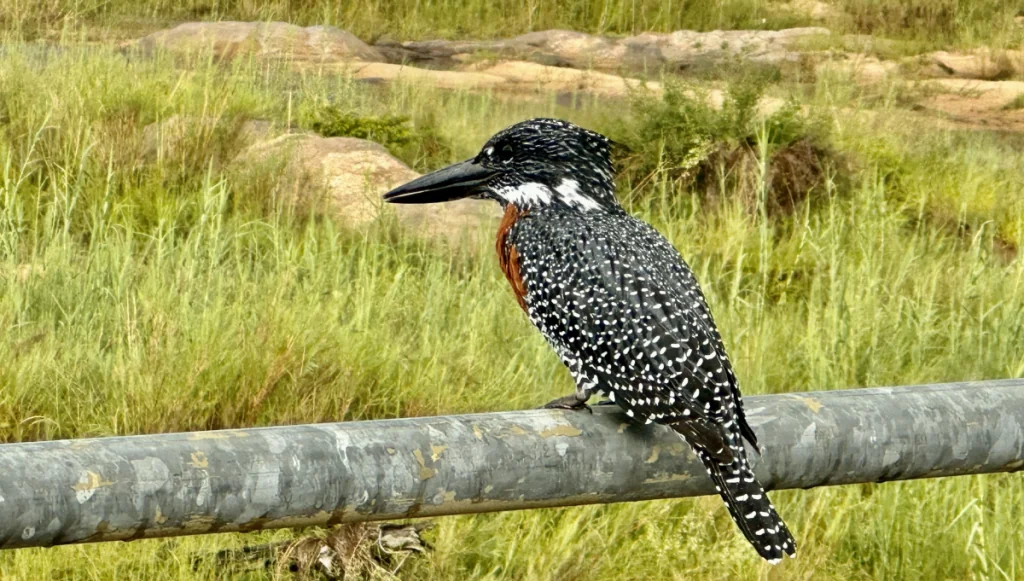
Shade tree, or shadow bird, is a bird with a special shape on its head.
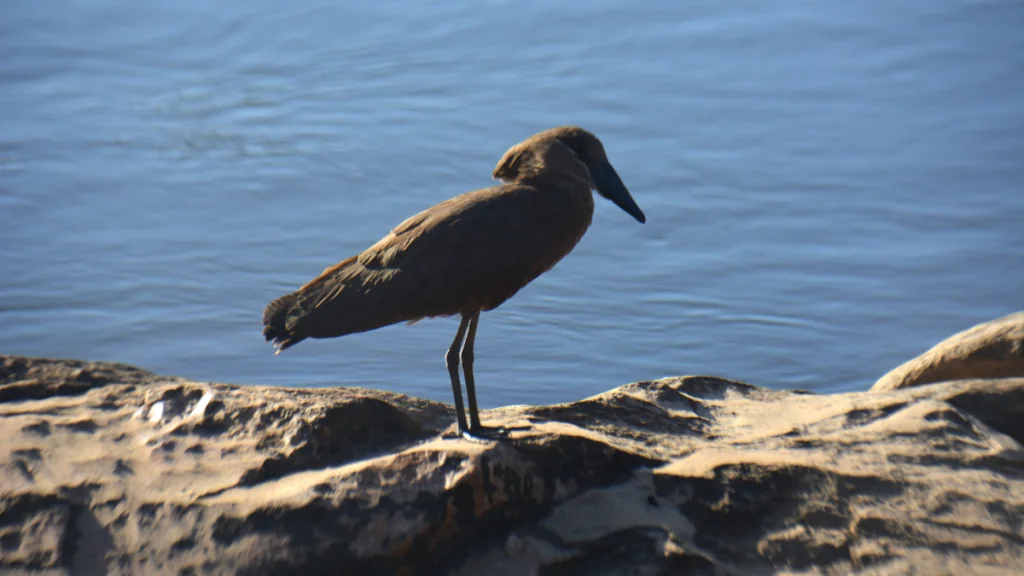
Screaming Fish Eagle is a powerful bird of prey, which we saw from a distance.
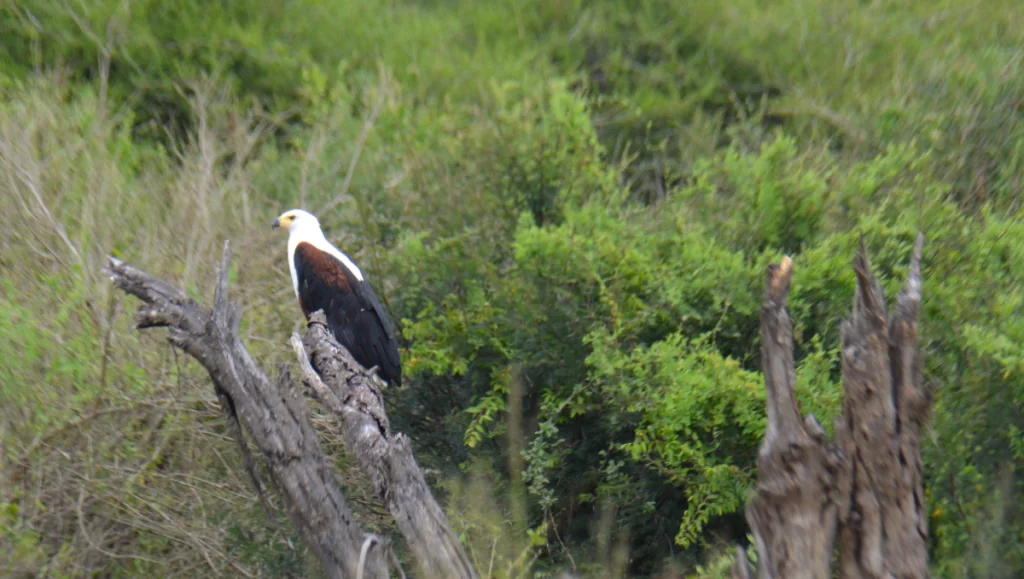
Purple-breasted Blue Crow is an incredibly beautiful and colourful bird, which we saw on several occasions.
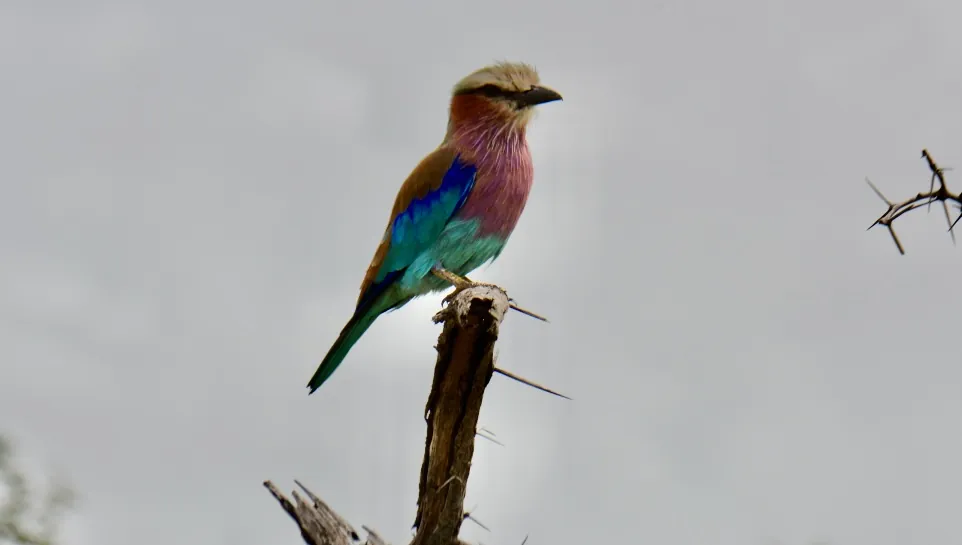
Racket-tailed roller was another small, and beautiful, bird that we saw on several occasions.
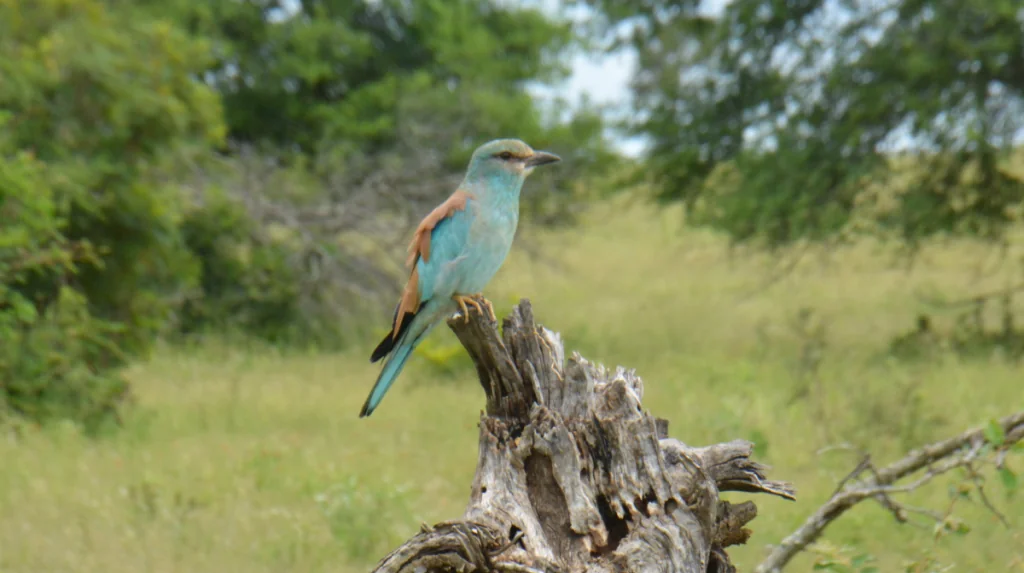
Southern hornbill is a large bird, which hunts spiders, snakes, lizards, insects and small mammals.
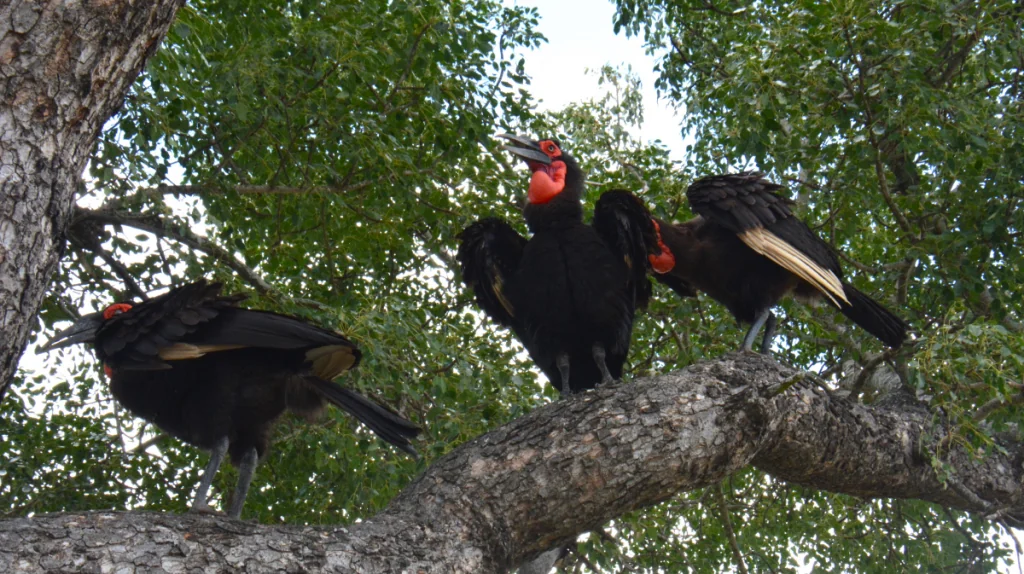
Southern Yellow-billed Hornbill we also saw several times. A beautiful bird!
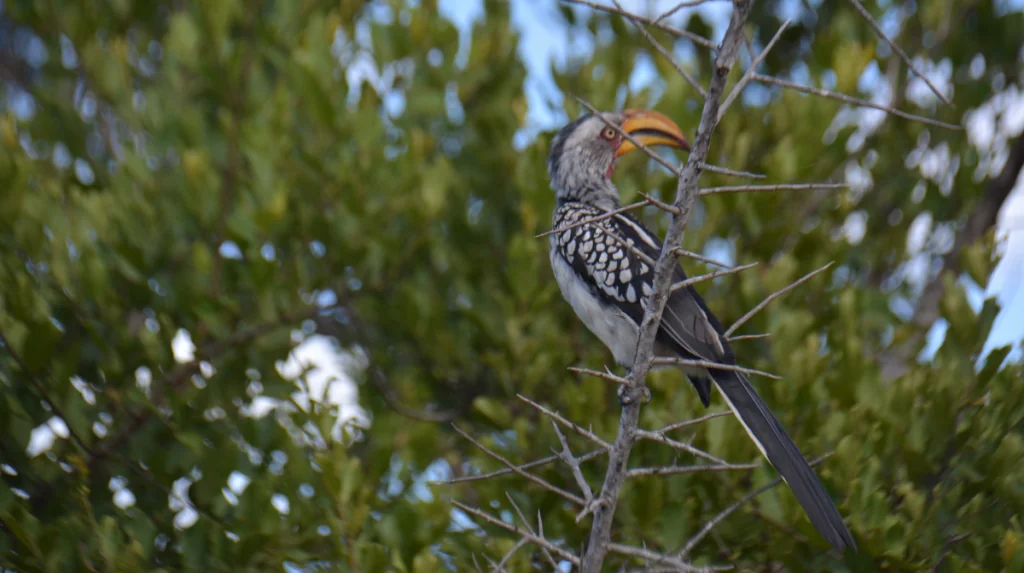
Other birds we saw were saddle-billed stork, black stork, white-fronted goose, hadadaibis, grasshopper sparrow, lapwing, crowned plover, lapwing, grey heron, tufted francolin, ostrich, red-billed oxpecker, greater glossy starling, green glossy starling, savannah kingfisher, grey kingfisher, Mozambique cuckoo, grey tufted turaco, southern masked weaver, Wahlberg's eagle, brown snake eagle, white-backed vulture and buzzard.
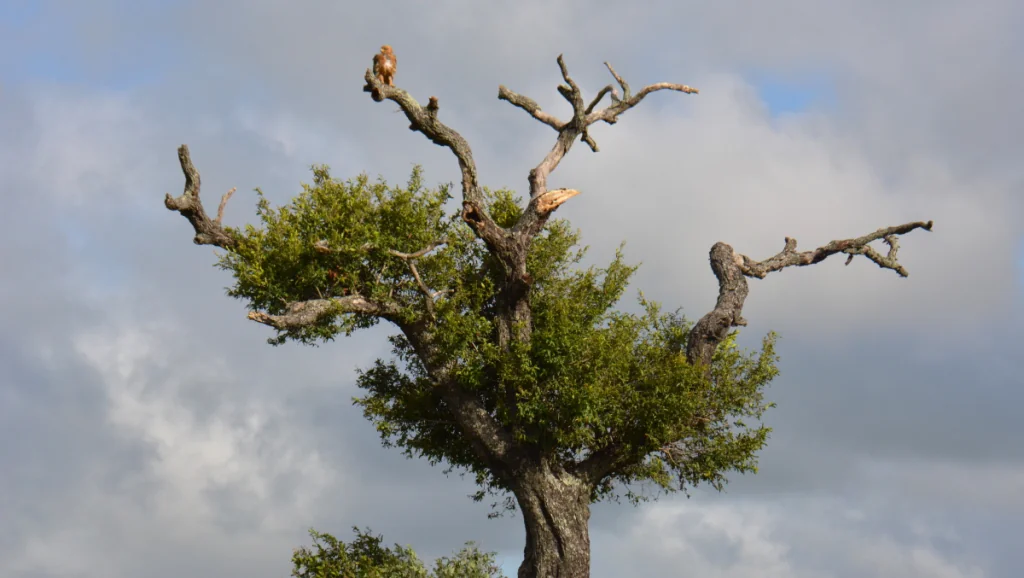
More animals in Kruger Park
Of course, there are even more animals in the Kruger Park besides mammals, reptiles and birds, such as butterflies and insects. Peter rescued a (big!) snail from the road so it wouldn't get run over.
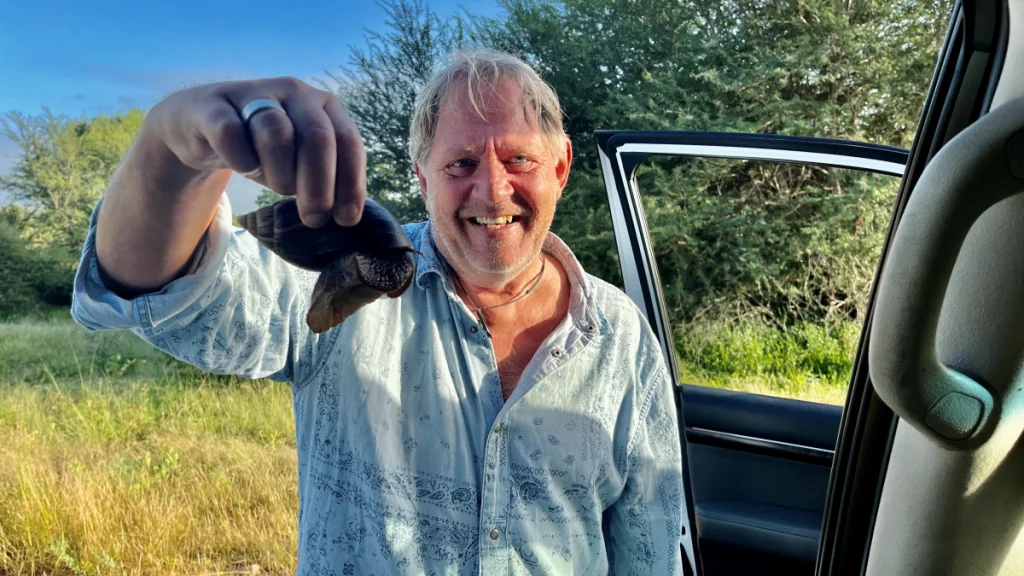
We also spotted several large termite stacks.
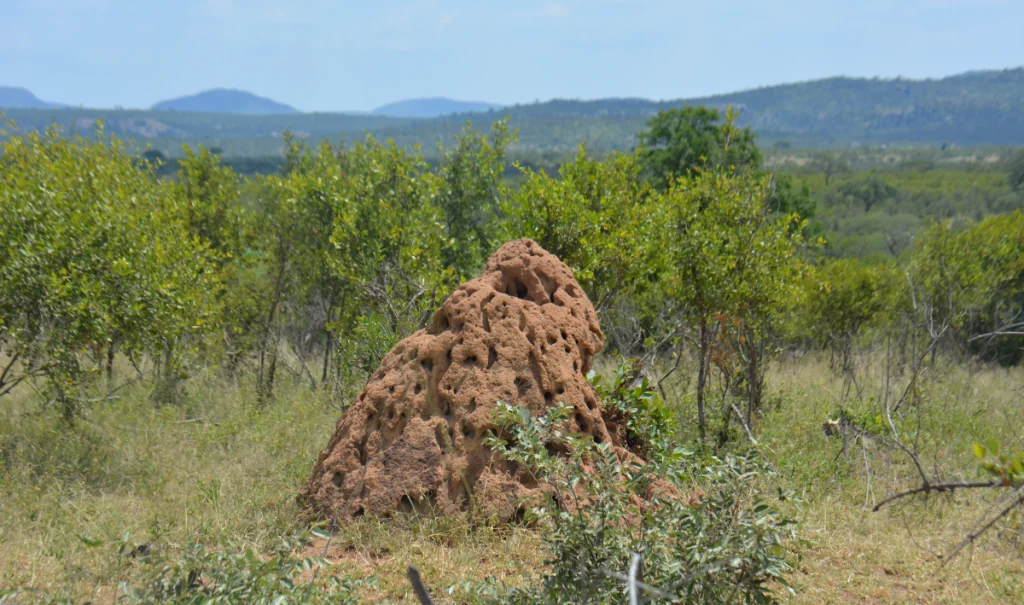
Have you seen animals in Kruger Park in South Africa?
Have you seen animals in the Kruger Park in South Africa, or would you like to? Do you have a favourite wild African animal?

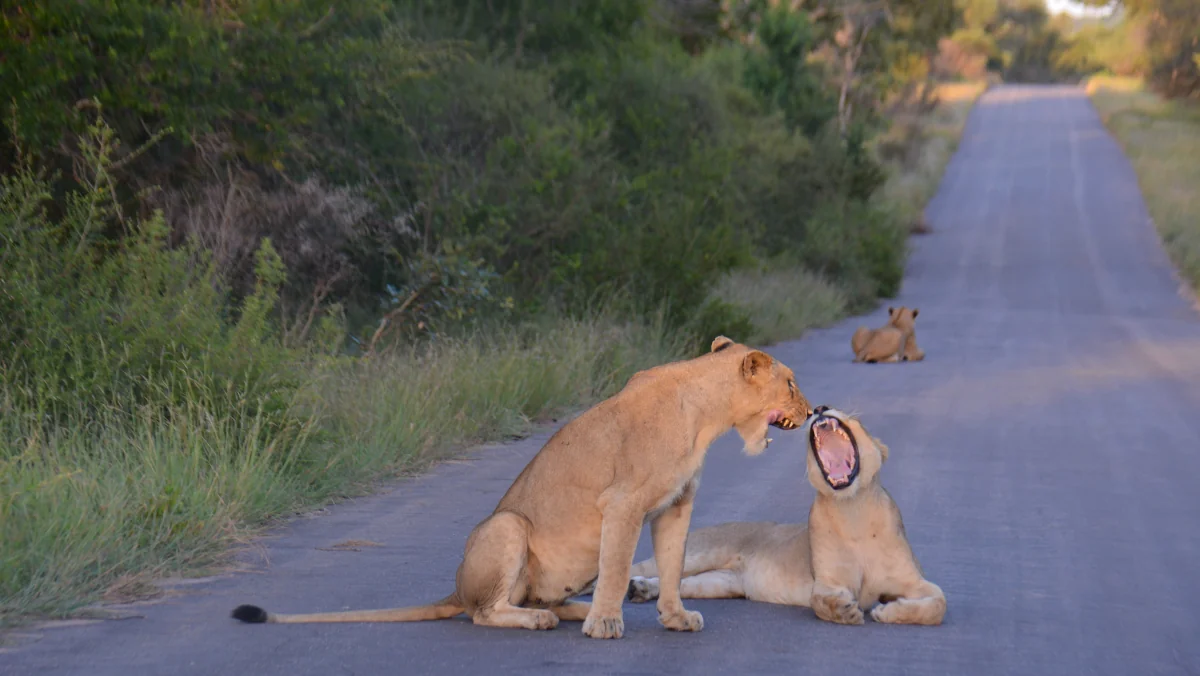










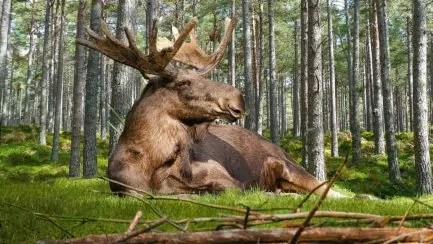
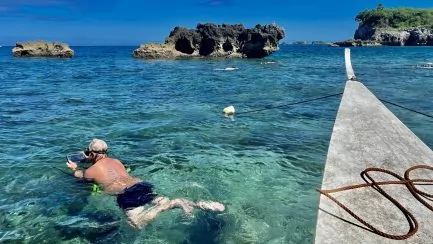
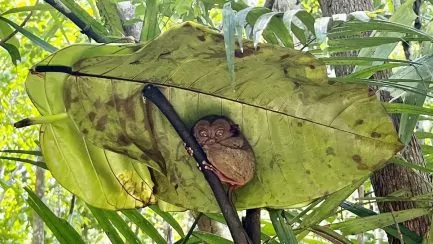
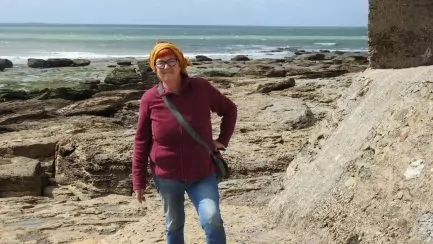
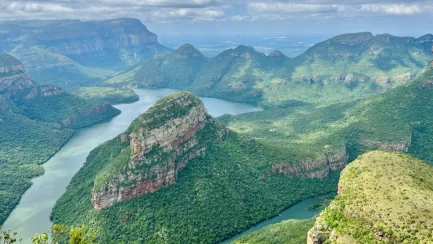



Anna Nilsson Spets says:
But my goodness how many species you have seen, great pictures. It is always difficult to photograph animals and especially birds. It's a shame about feeding animals, all to get the best picture or to be able to touch a wild animal.
10 February 2024 - 8:03
Helena says:
Yes, we were fascinated by how many species we saw! The birds were the most difficult to photograph, I agree. And yes sad that you don't understand that you shouldn't feed the animals, it is clearly written!
10 February 2024 - 17:58
Lena - gott för själen says:
Oh what fun to experience safari again with the help of your report! It was very many different animals that you saw. I don't think we saw quite so many in Tanzania. The most common ones we saw were wildebeest and zebras. Elephant and lion were also quite common. Nice that the buffaloes did not care about you. When we stood next to a herd of buffalo, it was the only time the driver had the car engine running. We understood that it was to be able to drive away quickly.
We got very close to a cheetah with kids too. It was powerful. You got a great picture of the leopard!
You seemed to have come quite close to the rhino. We saw it as a small dot, even with the zoom 🙂 But we have seen one! And the others in the big five gang.
Looking forward to more reports from an amazing trip!
Hug Lena
10 February 2024 - 8:27
Helena says:
Glad you liked the report! I understand that you had similar experiences, fantastic and very special!
10 February 2024 - 17:59
4000mil says:
Safaris in Africa are fantastic, aren't they? I have been away 4 times and never get tired. 😊
10 February 2024 - 17:15
Helena says:
Glad you were able to get away so many times! A special experience!
10 February 2024 - 17:59
BP says:
What great pictures! The header image with the two lions should be the cover of a glassy magazine.
Oh big CONGRATULATIONS to The Big Five, but as you write - the National Park offers soooo much more. I am very fond of these beautiful birds that are rarely presented, and I, for example, I have never seen before. So good with a booklet where you could tick off everything you saw.
Is entry to the National Park free, or is there an entrance fee?
Thank you so much for letting me ride shotgun with you again:-)
10 February 2024 - 17:53
Helena says:
Glad you like the pictures!!! 🙂 There is an entrance fee to the park. Tomorrow we will tell you about everything practical, how it works. (It became too long to write everything in the same post ;))
10 February 2024 - 18:01